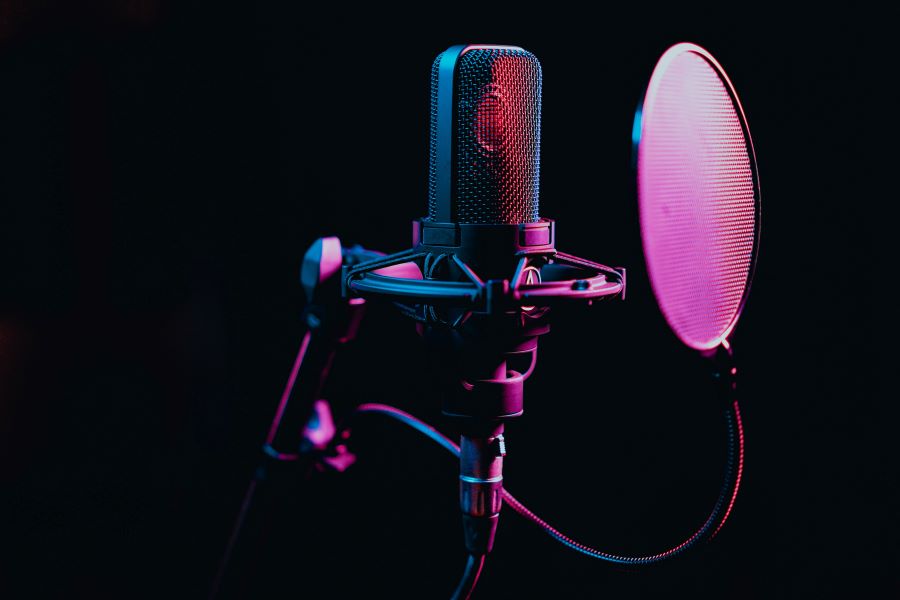Do you want to start a podcast but don’t know where to start? Or are you an experienced podcaster looking for the best pop filter for your setup? Either way, this blog post is for you.
In it, we’ll discuss the top eight best microphone pop filters for podcasting and what makes them great. So, read on for the best pop filter, whether you’re just starting or a seasoned pro.
Stay tuned!
Related: Podcast Starter Kit
What is a Pop Filter?
A pop filter is a device that attaches to your microphone and filters out unwanted noise from your recording. This includes things like breaths, plosives (hard “p” and “b” sounds), and other noises that can ruin takes. Pop filters are an essential part of any podcasting setup, so it’s important to choose the right one for your needs.
How Does It Work?
A pop filter diffuses the air pressure that comes into contact with the microphone. This effectively breaks up the airstream and prevents it from causing the microphone to “pop.” By doing this, you can avoid unwanted noise in your recordings.
Related: Podcast Mic Setup
Types Of Pop Filters
There are two main types of pop filters:
Nylon Mesh Pop Filters
Nylon mesh pop filters are a type of filter placed over the microphone to help reduce the amount of “pop” sound created when saying certain consonants.
The mesh helps to diffuse the air that is coming from the mouth and spread it out, which in turn reduces the amount of popping sound that is created. This filter is typically made from a very thin layer of nylon material, making it extremely lightweight and easy to use.
Advantages:
- Lightweight and easy to use
- Reduces popping sound
- It can be used with any microphone
- Inexpensive
- Its thinness does not affect the quality of sound
Disadvantages:
- The mesh can sometimes create a “hissing” sound
- The mesh can sometimes block out certain frequencies
- The mesh can sometimes be difficult to clean
Metallic Mesh Pop Filters
A metallic mesh pop filter is an acoustic filter placed between the vocalist and the microphone. It reduces plosives, the sounds made when air is released from the mouth.
Plosives can cause a “popping” sound when they hit the microphone, which can be distracting and difficult to edit. A pop filter helps to reduce this problem by absorbing the air before it hits the microphone.
Advantages:
- Prevents plosives from hitting the microphone
- Absorbs unwanted noise
- It can be used with any microphone
- It is easy to find.
- Its widescreen can filter more noise.
Disadvantages:
- Expensive.
- It is not as good at reducing noise as other types of filters.
- Its weight can cause it to fall off the microphone.
Nylon Vs. Metallic Mesh: Which is Better For You?
When choosing the best pop filter for your podcasting needs, nylon, and metallic mesh. Nylon filters are less expensive and easier to find, but they’re also less effective at reducing pops and clicks. Metallic mesh filters are more expensive, but they’re much more effective at reducing pops and clicks.
If you’re starting podcasting, a nylon filter may be your best option. Nylon filters are less expensive and easier to find, so you won’t have to spend much money to get started.
If you’re an experienced podcaster, a metallic mesh filter may be your best option. Metallic mesh filters are more expensive, but they’re much more effective at reducing pops and clicks. So, it depends on your needs.
8 Best Pop Filters For Recording Podcasts
1) Nady MPF-6
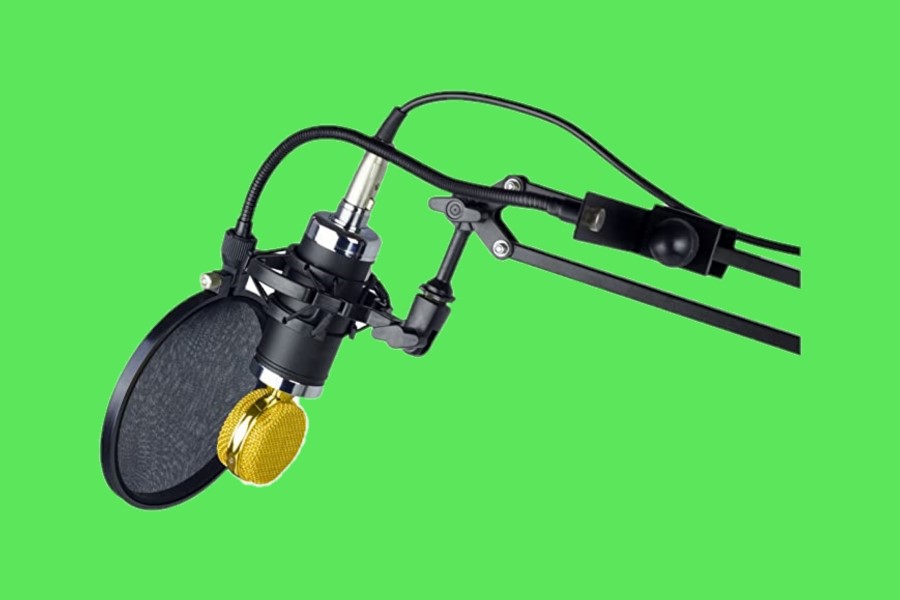
The Nady MPF-6 has a swivel mount for easy positioning, plus extra long and flexible gooseneck holder. Image Source.
Looking for a top-rated professional pop filter that also stops plosives? Look no further than the Nady MPF-6! This multi-positional windscreen features a top-quality pop filter and is also one of the most affordable options on the market.
Plus, it comes with a boom arm and swivels mount for easy positioning, making it perfect for any vocalist or podcaster. And thanks to its extra-long and flexible gooseneck holder, you can easily adjust it to fit your needs. So don’t wait – order your Nady MPF-6.
Pros:
- Stops plosives
- Affordable
- It comes with a boom arm and swivels mount
- Swivel mount for easy positioning
- Long flexible gooseneck holder
Cons:
- It may not fit all microphone stands
- It may not be as durable as some other options
2) Auray PFSS-55 Pop Filter
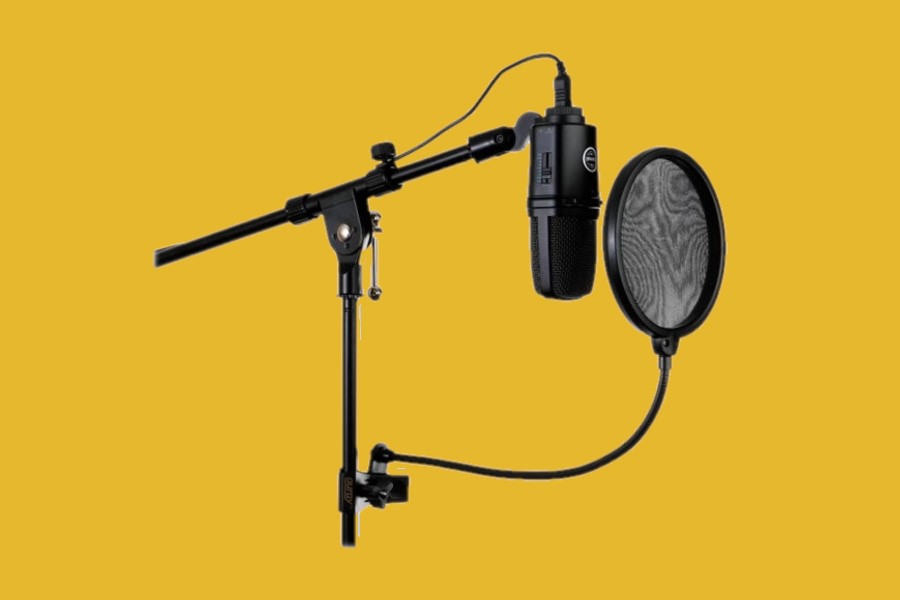
The Auray PFSS-55 Pop Filter with Gooseneck features double-layered nylon to greatly reduce noise from plosives. Image Source.
The Auray PFSS-55 Pop Filter is a 5.5˝ double-layered nylon pop filters that prevents vocal pops and protects your mic from corrosive moisture. The locking nut provides a secure hold, while the 13.5˝ gooseneck allows easy mounting.
The spring-loaded clamp makes it easy to attach to any microphone stand. This good pop filter also comes with a limited 1-year warranty. It’s the perfect choice for podcasting, recording, and live sound!
Pros:
- 13.5˝ Gooseneck
- Locking nut for a secure hold
- It has a spring-loaded clamp
- Its double-layered nylon pops
- 1-year warranty
Cons:
- The clamp may not be as secure as some other options
- The gooseneck may be too short for some users
3) Avantone PS-1 Pro Shield
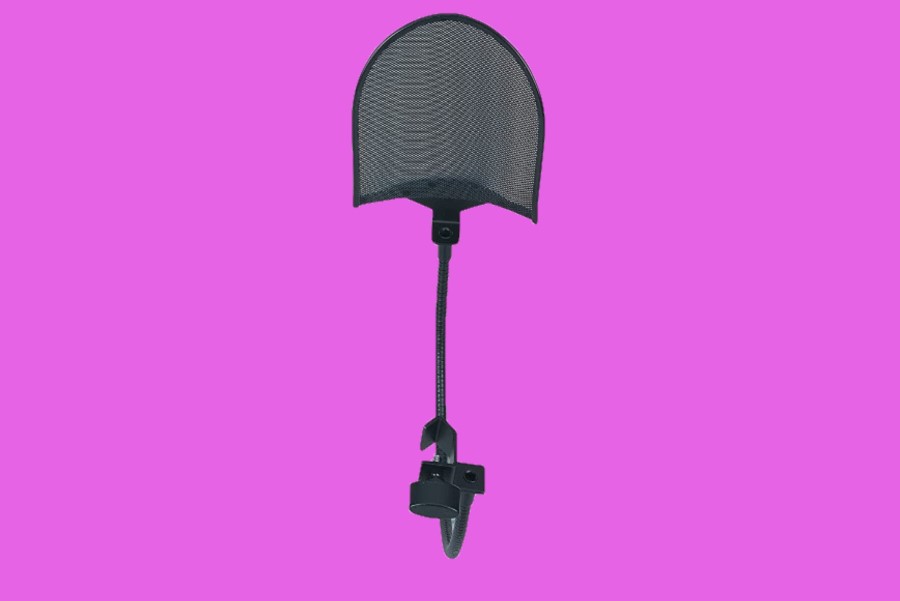
The PRO-SHIELD is constructed with an acoustically transparent metal screen that yields sonically superb results in studio applications. Image Source.
The AVANTONE PRO-SHIELD is the finest studio pop filter on the market. The specially designed curved pop filter surface allows for close work on a mic.
The PRO-SHIELD is constructed with an acoustically transparent metal screen to reduce plosives and protect your microphone.
With a 5-Year Warranty, the AVANTONE PRO-SHIELD is a must-have for any professional studio. So don’t wait – order your AVANTONE PRO-SHIELD today!
Pros:
- It is designed for curved surface
- It is made with an acoustically transparent metal screen
- It has a 5-year warranty
- Its construction protects the microphone
Cons:
- It may not be as durable as some other options
- It is more expensive than some other options
4) On-Stage ASFSS6-GB
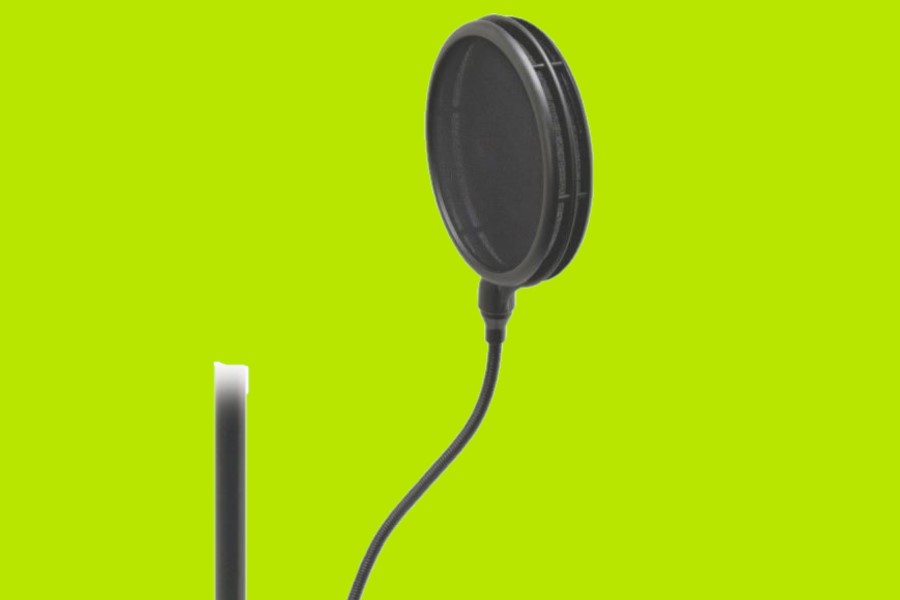
The ASFSS6-GBDual-Screen Pop Blocker has 6″ screen that reduces undesirable vocal pops and hisses. Image Source.
The On-Stage ASFSS6-GB is a heavy-duty gooseneck stand with 6.5 inches of height adjustment and a flexible gooseneck that extends 11.5 inches from the base.
The sturdy steel construction provides superior strength, while the non-conductive dual hoops with snap rings provide reliable performance and durability for years to come.
This black gooseneck microphone stand includes an easy-grip C-clamp that securely holds microphones, ensuring your performance goes off without a hitch!
Pros:
- Its material is the steel for the base
- It is non-conductive
- It has an easy-grip C-clamp
- It has a 6.5-inch height adjustment
- The gooseneck is 11.5 inches long
Cons:
- Its clamp may not be as secure as some other options
- The gooseneck may be too short for some users
5) Shure PS-6 Popper Stopper
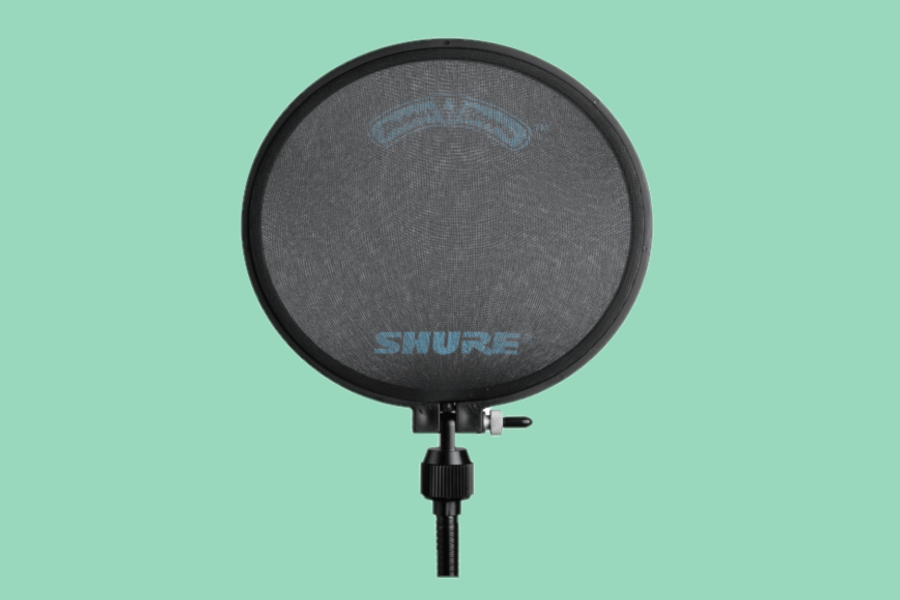
The PS-6 Popper Stopper’s windscreen attenuates unwanted breath noise and plosives and can be clamped to most stands. Image Source.
Shure’s PS-6 Popper Stopper is a professional-grade pop filter that helps reduce popping and sibilant sounds when recording vocals.
The metal filter is covered in four layers of nylon mesh to help protect your microphone from damage, while the engaging and winsome tone of voice will keep you sounding great. It is also adjustable to find the perfect fit for your needs. Order your Shure PS-6 Popper Stopper today!
Pros:
- It is lightweight.
- It is a great value.
- It is easy to find the perfect fit.
- It has an adjustable metal filter.
- The four layers of nylon mesh help protect your microphone.
Cons:
- Some users may find it difficult to adjust
- It may not be as durable as some other options
6) Stedman Proscreen XL Metal Pop Filter
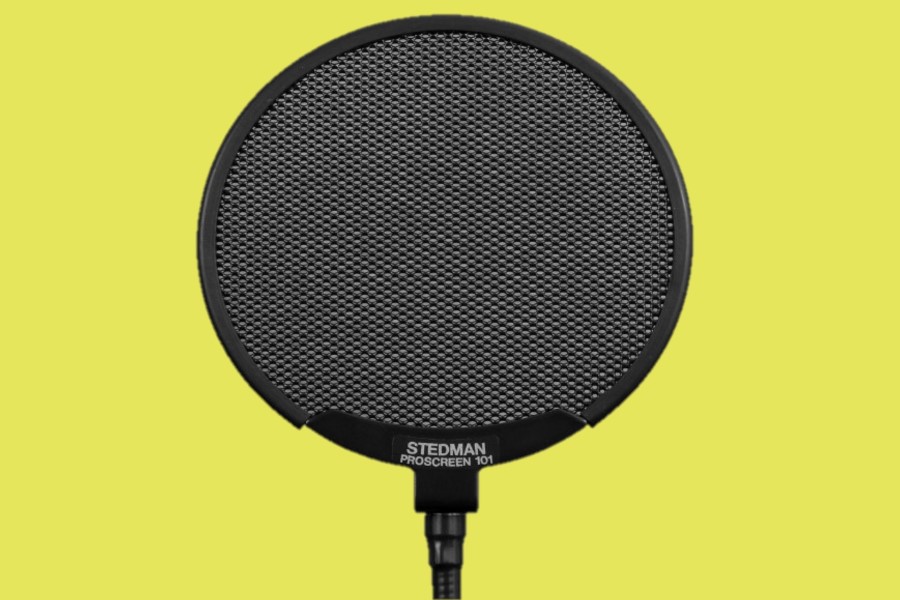
The Stedman Proscreen XL offers a large 6 inch diameter screen with an ultra-fine rubber surround that does not interfere with vocal recording sound quality. Image Source.
The Stedman ProScreen XL metal pop filter is a professional pop filter designed to provide the highest level of performance in terms of audio quality.
This model features an extra-large screen with a diameter of 6 inches, making it the perfect choice for recording instruments such as drums and guitar cabinets. Stedman ProScreen XL metal pop filters has a lightweight aluminum frame that can be adjusted to fit any stand or microphone holder up to 3.5 inches wide.
This model is made from premium materials and features an extra-large screen with a diameter of 6 inches, which makes it ideal for recording instruments.
Pros:
- It is made from premium materials.
- The extra-large screen has a diameter of 6 inches.
- It can be adjusted to fit any stand or microphone holder
- It has a lightweight aluminum frame.
Cons:
- Its clamp may not be as secure as some other options
- It is not a good choice for users who need a pop filter with a gooseneck
7) Blue THEPOP Universal Pop Filter
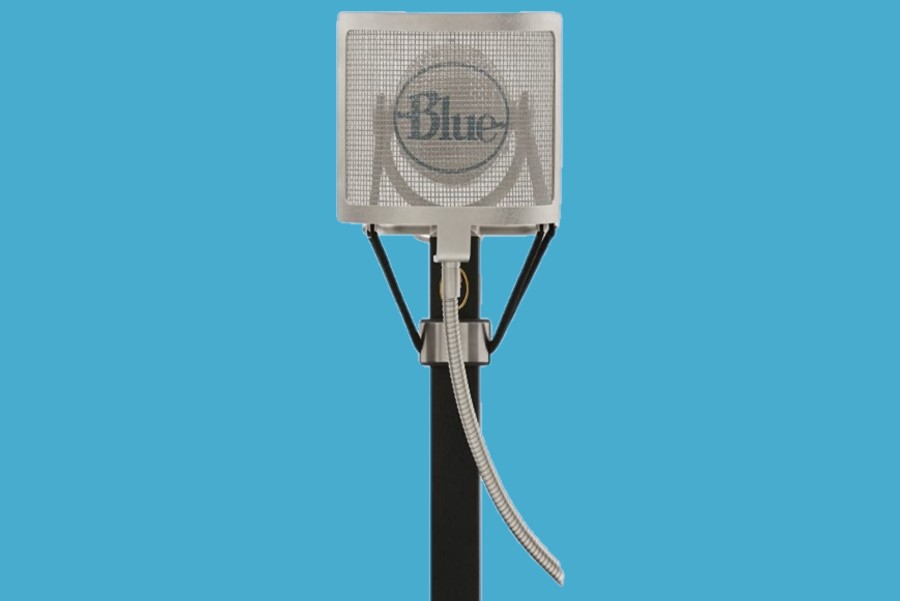
The Blue THEPOP Universal Pop Filter helps to reduce or eliminate popping sounds when fast moving air hits the microphone. Image Source.
The Blue THEPOP Universal Pop Filter helps to reduce popping sounds when recording vocals with any microphone.
It easily clamps to the mic stand, and its universal fit makes it compatible with any microphone. It also features a flexible gooseneck for easy positioning and an adjustable tension knob to hold it securely.
This pop filter also has a sleek and modern design, making it the perfect addition to any recording studio. While other pop filters may claim to be universal, the Blue THEPOP truly delivers on that promise.
Related: Pop Filter For Blue Yeti
Pros:
- Easily clamps to the mic stand
- Universal fit for any microphone
- Flexible gooseneck for easy positioning
- Adjustable tension knob to hold securely in place
- Sleek and modern design
Cons:
- The clamp may not be as secure as some other options
- Incompatible with very large or oddly shaped microphones
8) HAKAN P110 Pop Killer

The P110 has a hydrophobic foam construction that repels water, eliminating the typical distortion and coloration that plagues your vocals when breath moisture collects on your pop filter. Image Source.
The HAKAN P110 Pop Killer is a professional pop filter with an adjustable gooseneck, so you can position it exactly where you want. The pop guard’s foam is washable and replaceable, so it lasts longer than other filters.
This pop filter has a stand and clips for easy mounting to your mic pop filter stand. It also has a metal grid to help protect against damage from moisture or accidental contact. Use the HAKAN P110 as a stand-alone unit or pair it with a windshield for even greater sound protection.
Pros:
- It has an adjustable gooseneck
- The pop guard’s foam is washable and replaceable.
- It comes with a stand and clips
- Metal grid for protection
Cons:
- Some users may find it difficult to mount
- It’s only available in one size and may not fit all microphones well.
How to Choose the Best Pop Filter (Buying Guide)
Here are a few factors to consider when purchasing a pop filter:
Size
The pop filter should be large enough to cover the entire diameter of your microphone but not so big that it causes obstruction or affects sound quality.
Shape
Pop filters come in various shapes, including round and triangular ones. It ultimately comes down to personal preference, but some believe that a round pop filter produces a smoother sound, while a triangular own pop filter helps with plosive sounds. So, we recommend experimenting with both to find the shape that best suits your needs.
Mount
Pop filters can either attach directly to the microphone or have a gooseneck arm for more flexibility in positioning. Gooseneck arms offer more versatility but may be less stable.
Type
The important factor to consider with type is whether you want a foam or metal filter. Foam filters are cheaper and disposable but may need to be replaced more often. Metal filters are more durable but can alter sound quality. Again, it ultimately comes down to personal preference.
Price
Of course, budget is also a factor to consider. It is important to invest in a high-quality pop filter that will effectively reduce plosive sounds and improve the overall sound quality of your recordings. But, simultaneously, there is no need to break the bank. Shop around and find a pop filter that fits your needs and budget.
Overall, the best pop filter effectively reduces plosive sounds while not affecting the sound quality or causing an obstruction. All the pop filters mentioned above are great options to consider, but do your own research and find the one that best suits your needs.
Benefits Of Using A Pop Filter
- Prevents plosives, or popping sounds caused by hard consonants hitting the microphone
- It helps improve overall sound quality
- Can reduce the need for post-recording editing
- Can minimize breath noises and saliva buildup on the microphone
- It can protect the microphone from damage due to spit or moisture buildup
- It can add an extra layer of soundproofing for a quieter recording environment.
Related: How to Minimize Breathing Using Blue Yeti
Frequently Asked Questions (FAQs)
Do pop filters work?
Pop filters help reduce the harsh “p” and “b” sounds that microphones can pick up during recording. They also protect the microphone from spit and other debris.
Related: Do I Need a Pop Filter for the Rode PodMic?
Are windscreens and pop filters the same thing?
Windscreens are typically used outdoors to block wind noise, while most pop filters are used indoors during vocal recording. However, some products do combine both functions.
How far from my mic should I place my pop filter?
Generally speaking, a pop filter should be placed about 2-6 inches away from the microphone. However, this distance may vary depending on the strength of the plosives (such as the “p” and “b” sounds) in your speech, the positioning of the microphone, and personal preference. It is important to experiment with different distances to find the placement that best suits your needs.
Do you need a pop filter for your podcast?
While a pop filter may help reduce audio distortion caused by plosives, it is unnecessary for every podcast. Plosive sounds, created by the sudden release of air from consonant sounds like “p” and “b,” can often be minimized through proper microphone technique.
Can I use a foam mic instead of a pop filter?
It is possible to use foam mic covers as a substitute for pop filters, but they may not be as effective. Foam covers do not have the same tightness and precision as pop filters, so they may not eliminate plosives and other harsh sounds.
Foam covers can easily become worn or torn, while pop filters are typically made with durable materials. It is recommended to use a pop filter for optimal sound quality.
Do expensive pop filters make a difference?
There is no clear answer to this question as it ultimately depends on the specific product and individual preferences. Expensive pop filters may have more durable materials and a tighter mesh, potentially resulting in better sound quality.
However, there may also be less expensive pop filters that work just as well. It is important to research and consider your needs before investing in a pop filter.
Conclusion
Whether you’re a seasoned podcaster or just starting, adding a pop filter to your setup is one of the best ways to improve the quality of your recordings.
We’ve rounded up eight of the best pop filters for recording vocals and provided an overview of their features so that you can find the perfect fit for your needs.
So what are you waiting for? Start shopping and get ready to produce studio-quality episodes!
